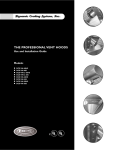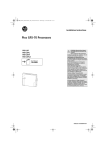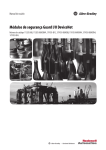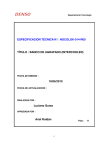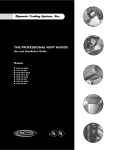Download DCS DCS-VH12-36S Installation guide
Transcript
Dynamic Cooking Systems, Inc. THE PROFESSIONAL VENT HOODS Use and Installation Guide Models: DCS-VH-48HS DCS-VH-48S DCS-VH12-36HS DCS-VH12-36S DCS-VH-36HS DCS-VH-36S DCS-VH-30HS DCS-VH-30S A Message To Our Customers Thank you for selecting this DCS Professional Vent Hood. Because of its unique features, we have developed this Use and Installation Guide. It contains valuable information on how to properly operate and maintain your new Vent Hood for years of safe and enjoyable cooking. To help serve you better, please fill out and return the Ownership Registration Card and keep this guide handy, as it will help answer questions that may arise as you use your New Vent Hood. For your convenience, product questions can be answered by a DCS Customer Service Representative by phone: 1-888-281-5698, or Fax: 714-372-7003, or by mail: DCS Attention Customer Service, 5800 Skylab Road, Huntington Beach, CA 92647 WARNING To reduce the risk of electrical shock or injury to persons all Vent Hoods must be installed with ventilators that have been approved for use with the hood. See Table A of this instruction manual for a listing of approved ventilators. PRECAUTION Do Not store or use gasoline or any other flammable vapors and liquids in the vicinity of this or any other appliance. PLEASE RETAIN THIS MANUAL FOR FUTURE REFERENCE. 1 Table Of Contents INTRODUCTION: The DCS Vent Hood Models have been designed with the ultimate in household convenience in mind. Features include High Capacity,Variable Speed Blower, Commercial Style dishwasher-safe filters, Easyto-Clean inside liner, and Illuminating Halogen Lighting, all packaged in a stylish, welded-seam exterior. Before proceeding with installation, please read this installation guide and observe all safety precautions and warnings. NOTE: Installation of this DCS Vent Hood must comply with all local codes. IMPORTANT- Save these instructions for the Local Electrical Inspector’s use. INSTALLER- Leave these instructions with the unit for the owner. SAFETY PRACTICES & PRECAUTIONS...............................................................................3 PLANNING THE INSTALLATION ..............................................................................................4 INNER LINER REMOVAL ..................................................................................................................4 VENT HOOD ASSEMBLY .................................................................................................................5 VENT HOOD INSTALLATION (WITH SOFFIT) .........................................................6-7 VENT HOOD INSTALLATION (WITHOUT SOFFIT) .................................................8 FINISHING THE INSTALLATION ...............................................................................................9 DUCT INFORMATION ....................................................................................................................10 DCS VH SERIES SPECIFICATIONS .........................................................................................11 HOW TO OBTAIN SERVICE ........................................................................................................12 WARRANTY ............................................................................................................................................13 WIRING DIAGRAM ......................................................................................................................14-15 2 Safety Practices & Precautions WARNING: To reduce the risk of a range top grease fire: A) Never leave surface units unattended at high settings. Boilovers cause smoking and greasy spillovers that may ignite. Heat oil slowly on low or medium settings. B) Always turn hood “ON” when cooking at high heat or when cooking flaming foods. C) Clean ventilating fans frequently. Grease should not be allowed to accumulate on fan or filter. D) Use proper pan size. Always use cookware appropriate for the size of the surface element. Make-Up air may be necessary to prevent air flowing down chimney, unsealed door, window, or fireplace opening. WARNING: To reduce the risk of fire, electrical shock, or injury to persons, observe the following guidelines. A) Installation and Electrical Wiring Must Be Performed By Qualified Personnel In Accordance With All Applicable Codes & Standards, Including Fire-Rated Construction. B) To Prevent Backdrafting, sufficient air is needed to maintain proper combustion and safe exhausting of gases through the flue (chimney) of fuel burning equipment. Follow the cooking equipment manufacturers guideline and safety standards such as those published by the National Fire Protection Association (NFPA) and the American Society for Heating, Refrigeration and Air Conditioning Engineers (ASHRAE), and the local code authorities. C) Use caution when cutting or drilling into walls or ceilings as not to damage electrical wiring and other hidden utilities. CAUTION:To Reduce the risk of fire and to properly exhaust air, be sure to duct air to outside. -do not vent exhaust air into spaces within walls or ceiling, nor into attics, crawl spaces, or garages. NOTE: unit MUST be vented to the outside of the building. WARNING:To reduce the risk of electrical shock or injury to persons, all vent hoods must be installed with ventilators that have been approved for use with the hood. Ventilator Use: *All Ventilator Models used in DCS Professional Vent Hoods are approved by Underwriters Laboratory TABLE A: Vent Hood Model use with Ventilator Model DCS-VH-48HS DCS-IB12 (1200 CFM) DCS-VH-48S DCS-IB12 (1200 CFM) DCS-VH12-36HS DCS-IB12 (1200 CFM) DCS-VH12-36S DCS-IB12 (1200 CFM) DCS-VH-36HS DCS-IB6 (600 CFM) DCS-VH-36S DCS-IB6 (600 CFM) DCS-VH-30HS DCS-IB6 (600 CFM) DCS-VH-30S DCS-IB6 (600 CFM) 3 Planning The Installation BACKDRAFT DAMPER: We recommend that a backdraft damper be used in all Vent Hood installations. Cold weather installations necessitate the use of a backdraft damper to minimize the flow of cold air into the room. A nonmetallic thermal break should also be installed to minimize conduction of outside temperatures through the ductwork. Locate the thermal break as close as possible to where the ducting enters the heated portion of the house. PLANNING THE INSTALLATION: Before beginning installation of the Vent Hood and Ventilator, PLAN OUT the entire installation procedure beforehand, considering the following areas: 1. HOOD SIZE & LOCATION- (The hood should be as wide or wider than the cooking appliance with the hood being centered on the appliance.Vertically, the bottom of the hood should be between 30”36” above the appliance cooking surface). 2. DUCTING- (ducting transitions, air flows to outside? Use of Backdraft damper? ...etc.) 3. ELECTRICAL REQUIREMENTS- (120 Volts, 60 Hz, 15 AMP Service, Local Codes...etc.) 4. ADEQUATE MOUNTING SURFACES- (location of wall studs, additional support for safe wall mounting...etc.) HANDLING NOTE- This Hood has been inspected prior to shipping to be free of defects. Due to the weight of the Vent Hood and Ventilator and to prevent scratching or denting the unit, we recommend the use of two installers to move, place, and secure the Vent Hood to avoid personal injury or damage to the Hood. INNER LINER REMOVAL: The DCS Professional Vent Hood has been designed into (2) major assemblies to accommodate easy and safe installation. The following procedure is best done with the Hood on its back on a padded surface. The inside liner assembly can be separated from the outer hood assembly by removing the (12) inner perimeter screws- (3 each side/front/back). Once these screws have been removed, the liner assembly can slide down to gain access to the male/female disconnect plug- See Fig.8 on page 5. After the disconnect plug has been unplugged, the liner assembly can be set aside until the hood has been installed into the soffit or wall. MODEL IDENTIFICATION: DCS-VH-36HS (w/ Heat Lamps) DCS-VH-36S (standard) DCS-VH-48HS (w/ Heat Lamps) DCS-VH-48S (standard) DCS-VH12-36HS (w/ Heat Lamps) DCS-VH12-36S (standard) 4 DCS-VH-30HS (w/ Heat Lamps) DCS-VH-30S (standard) Vent Hood Assembly FIG.08 DCS Duct Cover (6" or 12" Height) Rough-In Kit junction box Rough-In Kit A B junction box Through junction box on rough-in kit, connect to house wiring to blower motor Hood Inner Liner (Remove) ( 48" Model Liner Shown) FIG.07 Model DCS-IB12 Blower DCS VH 48 DCS VH12 36 Model DCS-IB6 Blower DCS VH 36 DCS VH 30 control panel Blower Hood Lights Hood Light Bulb-2ea. - + L. Heat Lamp Blower Speed (not all models) 5 R. Heat Lamp (not all models) Vent Hood Installation (with soffit) SITE PREPARATION: This DCS Professional Vent Hood has been designed to accommodate installation into a 1) soffit structure (ceiling mount), or, for sites without a soffit structure. 2) directly into the wall through holes provided in the rear panel of the vent hood (wall mount). When mounting the hood to a soffit, it is recommended to also utilize the rear panel holes to gain additional stability and minimize any vibration noise. We suggest that the final framing and wall finishing be done with the vent hood at the site to more accurately locate ductwork and electrical service. CONSTRUCT SOFFIT FRAMING: 1) For a site with a soffit, use 2” x 4”s to construct the soffit framing as shown below in Fig. 1. Note that a minimum opening of 10” is needed to accommodate the ductwork. With the centerline of the installation marked, nail down the 2” x 4”s (wide side down) so that their inner edges are those specified from the centerline. -see Figs.1 & 3 pg.7 Note: The second (outer) set of 2” x 4”s are not necessary on the 30” Models installation. 2) Make 2 wood shims (2” x 10-1/2” x drywall thickness). Attach them to the framing as shown in Fig.2. Mount shims flush with inner edges of framing and with front edges 11-1/2” from finished back wall. FIG.02 FIG.01 10in"imum M "A" SHIMS "A" D WID T H Finished Drywall "A" = Center line to inner edge of 2 x 4's. -see fig.4. 6 " 1/2 11- HOO Vent Hood Installation (with soffit) INSTALL VENT HOOD INTO SOFFIT: At this point in the installation process, the inner liner should be removed from the Hood and set aside (see-Pgs 5 & 6).With the liner set aside, there is clear access to the Soffit mounting holes and wall mounting holes in the rear panel of the unit. Once the soffit framing has been completed, place assembled vent hood (hood, rough-in kit, and ventilator) into place and secure hood to the soffit frame with 6 wood screws. NOTE: Additionally, we recommend the installer utilize the holes provided in the rear panel of the hood to secure the hood to the rear wall and minimize any noise and vibration of the unit. NOTE: Assure that the mounting screws are long enough to be driven through the wood shims into the installed 2” x 4”s for total support. -see fig.3 -GO TO FINISHING THE INSTALLATION- Pg. 9 FIG.03 TOP VIEW (48" MODEL SHOWN) "B" "B" Rough-in Kit (23-1/2 x 10-1/2") ALL MODELS 12" 2 x 4's installed per Fig. 1 25" 3/8" Soffit mounting holes in Vent Hood (6 total) 2 x 4's in Soffit Outer 2 x 4's (48" Models only) FRONT VIEW "A" Rough-in Kit Soffit Mounting Screws (6) 7 CEILING DRYWALL Vent Hood Installation (without soffit) SITE PREPARATION: In cases where the installation site does not have a soffit structure, the Vent Hood assembly may be secured directly to the wall from the rear of the unit. NOTE- When installing the vent hood directly to the rear wall, an adequate structural wall support (studs) must exist to secure the unit. NOTE- The DCS Duct Cover should be ordered and installed when installing the vent hood in a site without a soffit. DCS offers both a 6” and 12” height Duct Covers. Keep the 6 or 12 inch dimension in mind when allowing for clearance between the top of the Vent Hood and the ceiling. (see Fig. 4) 1. With the Vent Hood width, and installation site in mind, mark the centerline of the installation. 2. See the chart in Fig.4 to determine the centerline to centerline dimension of wall mounting holes for the particular model being installed. 3. Cut away enough drywall (if installed) to expose 2 vertical studs (1 on each side of the Hood center line) It will be necessary to A) construct a plywood wall insert (See Fig 5) or B) install aligning wall studs. (See Fig 6). WALL MOUNTING: After an adequate wall structure has been completed, secure the DCS Duct Cover (6” or 12”) to the top of the vent hood. Carefully lift the hood with the duct cover into the installation site and secure the hood into the wall structure with 6 (six) mounting screws. Once the Hood assembly has been secured to the wall, the front of the Soffit Chimney may be removed for ductwork connections. -GO TO FINISHING THE INSTALLATION Pg.9 FIG.05 FIG.06 10"imum Min 10"imum Min HOOD HOOD WIDTH WIDTH "C" Additional Wall Studs Installed "C" Centerline of installation space. No additional wall studs needed Plywood Sheet (wall hole cut out x drywall thickness") 8 Finishing The Installation TO FINISH THE INSTALLATION: FIG.04 REAR VIEW of VENT HOOD (48" Model Shown) Once the ventilation hood has been mounted in place it will be necessary to install the electrical service. All electrical work should be done by a qualified electrician and must conform to all local standards. Refer to the wiring diagrams on Pgs. 14-15, for proper hook-up and grounding. CEILING DRYWALL 6" or 12" Duct Cover 3-1/2" Hood Centerline 6-1/2" CL 18" 6-1/2" NOTE: Black=live,White=neutral, Green=ground "C" Complete installation by making ductwork connections, testing unit functions, and installing & finishing drywall. MODEL CARE AND USE: "C" "A" (see fig.1) "B" "C" (see fig.3) (see fig.4 above) All 48" Vent Hoods 9-1/2" 13" 13" All 36" Vent Hoods 9-1/2" 12.7/16" 9" All 30" Vent Hoods 9-1/2" 12.7/16" 9" CONTROLS- We recommend you turn your hood on before you begin cooking to establish fresh air flow. After you've finished cooking, let the blower run for a few minutes to clear the air and help keep the kitchen fresh and clean. BLOWER- The blower is operated with 2 controls. The switch adjacent to the speed control turns the blower on/off, while the speed control adjusts the blower speed. Turn the speed knob clockwise to increase and counterclockwise to decrease the blower speed. HOOD LIGHTING- A single switch controls both lights. Use only 50W Max. Halogen Narrow Flood replacement bulbs. CAUTION: Halogen lamps are constructed of a glass bulb with a pressurized internal filament tube that operates at high temperatures and could unexpectedly shatter. Should the outer bulb break, particles of extremely hot glass could be discharged into the fixture enclosure and/or surrounding environment, thereby creating a risk of personal injury or fire.When replacing the bulb, let the bulb cool, and assure that power to light has been turned off. Never allow hot bulb to come into contact with water. Do Not Touch the Hood Light Bulbs when in use.They may be hot enough to cause injury. WARMING LAMPS- Each warming lamp is controlled by its own on/off switch. Use only R40 size, 250W Max. Infrared bulbs. FILTERS- Filters should be cleaned frequently in a detergent solution and are dishwasher safe. Empty grease collection tray/s regularly. Remove filter/s by gently pulling up and out. Grease collection tray/s are beneath each filter/s. UNPLUG the BLOWER MOTOR BEFORE CLEANING VENTILATOR. -Remove filters to access blower motor plug. Vacuum blower to clean. Do not immerse in water. -Do not allow an excessive accumulation of grease. -Use a mild detergent when cleaning. -Do not use harsh abrasives, steel wool pads, or abrasive cloths. 9 Duct Information GENERAL: 10" - When planning the path for ducting to the outside, keep in mind the following guidelines: - Minimize use of elbows and transitions in ductwork as to maximize air flow to outside of building. An efficient airflow path contributes to the overall efficiency of the Vent Hood. - DCS recommends the use of smooth wall ducting, not flexible ductwork. - Transitions are required from rectangular to round ducting 11" 10-1/2" 18-5/8" 4-5/8" Vertical Duct Transition DCS-IB12 BLOWER Requires one of the following 4-1/2” x 18” to 10” round transitions (purchase separately) Model 19052-01-Vertical discharge Model 19052-02-Rear discharge Model 19052-03-Left discharge - Duct tape may be used at ducting joints. DCS-VH-48 / DCS-VH12-36 REQUIREMENTS: - DCS recommends the use of 10” round ducting which provides 78.6 sq. In. of surface area. - Alternate duct sizes in rectangular style may be used. If a rectangular duct style is used, the duct must equal at least 78.6 sq. In. for best results. (Example- 3-1/4” x 24” duct = 78 sq. In.) - Maintain consistent ducting square area as to avoid reduced air flow. [ie.- With a VH-48 Hood, connecting a 4”x13” (52 sq. In.) to a 10” round (78.6 sq. In.) is not recommended] DCS-VH-36/30 REQUIREMENTS: - DCS recommends the use of 7” round ducting which provides 34.7 sq. In. of surface area. - Alternate duct sizes in rectangular style may be used. If a rectangular duct style is used, the duct must equal at least 34.7 sq. In. for best results. DUCT ACCESSORIES: - Wall Caps and Roof Caps must have free open area equal to duct size diameter. - Note that a Sealed Back Draft Damper may reduce air delivery. 10 DCS VH Series Specifications 12" " 6",12 " 18 Specify 48",36",30" Spec ify 48 DCS VH SERIES SOFFIT CHIMNEY DUCT COVER 25" ",36" ,30" 12" DCS VH SERIES HOODS 7" 7-1/4" 3" 3/4" 4-1/2" 23-1/2" 3" 10-1/4" 3/4" 23-1/2" 10-1/4" 10-1/4" 10-1/4" 12-1/4" 18-1/4" 10-1/4" 10-1/4" MODEL DCS IB6 BLOWER AND ROUGH IN KIT MODEL DCS IB12 BLOWER AND ROUGH IN KIT MODEL DCS IB6 BLOWER VOLTS HZ 120 60 AMPS 3.3 CFM 600 DUCT 7” ROUND MODEL DCS IB12 BLOWER 120 5.0 1200 10” ROUND 60 11 Service HOW TO OBTAIN SERVICE: Before you call for service: 1) Is the circuit breaker tripped or the fuse blown? 2) Is there a power outage in the area? For warranty service, contact your local DCS authorized service agency. Provide him with the Model Number, Serial Number, and date of installation, and a brief description of the problem. If you need assistance in locating the authorized service agency in your area please contact our DCS Customer Service Department for an authorized service agent near you, our number is (888) 281-5698. Your satisfaction is of the utmost importance to us. If a problem cannot be resolved to your satisfaction, please write or fax us at: 714-372-7003. Write: DCS Attention: Consumer Relations 5800 Skylab Road Huntington Beach, CA 92647 12 Warranty LENGTH OF WARRANTY: One (1) Year Full parts and Labor Covers the entire product Five (5) Year Limited warranty covering the switches and motor. DCS WILL PAY FOR All repair labor and parts found to be defective due to materials or workmanship for one full year “IN HOME” warranty during the first year of ownership. This does not apply if the unit was subjected to other than normal household use. Service must be provided by Authorized Factory Agent during normal working hours. No charges will be made for repair or replacement at the location of initial installation or factory for parts returned pre-paid, through the dealer and claimed within the warranty period, and found by DCS to be defective. Replacement will be F.O.B. DCS, and DCS will not be liable for any transportation costs, labor costs, or export duties. This warranty shall not apply, nor can we assume responsibility for damage that might result from failure to follow manufactures instructions or local codes, where the appliance has been tampered with or altered in anyway or which, in our judgement, has been subjected to misuse, negligence, or accident. Implied warranty shall not extend beyond the duration of this written warranty.This warranty is in lieu of all warranties expressed or implied and all other obligations or liability in connection with the sale of this appliance. DCS WILL NOT PAY FOR • • • • • • • Installation or start-up. Shipping damage. Service by an unauthorized agency. Damage or repairs due to service by an unauthorized agency or the use of unauthorized parts. Service during other than normal working hours. Improper installation, such as improper hook-up, etc. Service visits to teach you how to use the appliance; correct the installation; reset circuit breakers or replace home fuses. • Repairs due to other than normal household use. • Damage caused from accident, abuse, alteration, misuse, incorrect installation or installation not in accordance with local codes. • Units installed in non-residential application such as day care centers, bed and breakfast centers, churches, nursing homes, restaurants, hotels, schools, etc. This warranty applies to appliances used in residential applications; it does not cover their use in commercial situations. This warranty is for products purchased and retained in the 50 states of the U.S.A., the District of Columbia and Canada.This warranty applies even if you should move during the warranty period. Should the appliance be sold by the original purchaser during the warranty period, the new owner continues to be protected until the expiration date of the original purchaser’s warranty period. This warranty gives you specific legal rights.You may also have other rights which vary from state to state. 13 Wiring Diagram DCS VH 48 48" VENT HOOD WIRING DIAGRAM 1200 CFM MOTOR JUNCTION BOX (L1) BLK (N) WHT WN-3 (GROUND) GRN 6 8 MOTOR PLUG BLOWER MOTOR WHT BLK 5 16 7 1 2 3 4 5 CONNECTORS: 6 FEMALE 1 2 3 4 5 6 9 2 14 MALE USED ON HS MODELS ONLY 3 USED ON HS MODELS ONLY LEFT HEAT LIGHT brass 17 RIGHT HEAT LIGHT 17 brass zinc zinc 14 19 19 20 18 19 9 20 LEFT LIGHT 10 17 1a 1b 12 2 1 LEFT HEAT LIGHT SWITCH 10 14 15 2b 1a 1b 15 SPEED CONTROL 1a 1b 11 FAN SWITCH 4 19 3 WN-2 WN-1 LIGHT SWITCH 1a 1b 12 17 13 RIGHT HEAT LIGHT SWITCH RIGHT LIGHT 11 13 1 (L1) BLK 36" / 30" VENT HOOD WIRING DIAGRAM (N) WHT 600 CFM MOTOR WN-3 BLOWER MOTOR 8 (GROUND) GRN 6 16 WH BLK 1 2 1 2 3 3 9 19 15 LEFT LIGHT 12 1 5 4 5 14 6 FEMALE 6 MALE 3 17 zinc 19 11 2 4 USED ON HS MODELS ONLY HEAT LIGHT brass CONNECTORS: 5 7 18 17 18 1a 1b HEAT LIGHT SWITCH 11 15 15 1a 2b SPEED CONTROL 1b 1a 1b 4 10 FAN SWITCH 14 3 WN-2 WN-1 LIGHT SWITCH 9 10 RIGHT LIGHT 13 12 1 2 Wiring Diagram DCS VH 30/36 JUNCTION BOX
















